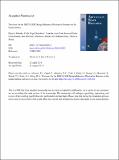Files in this item
Traverses for the ISECG-GER Design Reference Mission for humans on the lunar surface
Item metadata
| dc.contributor.author | Allender, Elyse | |
| dc.contributor.author | Orgel, Csilla | |
| dc.contributor.author | Almeida, Natasha | |
| dc.contributor.author | Cook, John | |
| dc.contributor.author | Ende, Jessica | |
| dc.contributor.author | Kamps, Oscar | |
| dc.contributor.author | Mazrouei, Sara | |
| dc.contributor.author | Slezak, Thomas | |
| dc.contributor.author | Soini, Assi-Johanna | |
| dc.contributor.author | Kring, David | |
| dc.date.accessioned | 2019-08-30T23:40:09Z | |
| dc.date.available | 2019-08-30T23:40:09Z | |
| dc.date.issued | 2019-01-01 | |
| dc.identifier | 252924032 | |
| dc.identifier | d3c4dd8b-624c-4292-bb6e-1daf102105b8 | |
| dc.identifier | 85053002436 | |
| dc.identifier | 000457510000052 | |
| dc.identifier.citation | Allender , E , Orgel , C , Almeida , N , Cook , J , Ende , J , Kamps , O , Mazrouei , S , Slezak , T , Soini , A-J & Kring , D 2019 , ' Traverses for the ISECG-GER Design Reference Mission for humans on the lunar surface ' , Advances in Space Research , vol. 63 , no. 1 , pp. 692-727 . https://doi.org/10.1016/j.asr.2018.08.032 | en |
| dc.identifier.issn | 0273-1177 | |
| dc.identifier.other | ORCID: /0000-0002-0052-7895/work/64698158 | |
| dc.identifier.uri | https://hdl.handle.net/10023/18396 | |
| dc.description | This work was carried out through the 2016 Exploration Science Summer Intern Program hosted by the Lunar and Planetary Institute (LPI) and Johnson Space Center (JSC). This research was supported in part by the NASA Solar System Exploration Research Virtual Institute (SSERVI). | en |
| dc.description.abstract | This study explores the Design Reference Mission (DRM) architecture developed by Hufenbach et al. (2015) as a prelude to the release of the 2018 Global Exploration Roadmap (GER) developed by the International Space Exploration Coordination Group (ISECG). The focus of this study is the exploration of the south polar region of the Moon, a region that has not been visited by any human missions, yet exhibits a multitude of scientifically important locations – the investigation of which will address long standing questions in lunar research. This DRM architecture involves five landing sites (Malapert massif, South Pole /Shackleton crater, Schrödinger basin, Antoniadi crater, and the South Pole-Aitken basin center), to be visited in sequential years by crew, beginning in 2028. Two Lunar Electric Rovers (LER) are proposed to be tele-robotically operated between sites to rendez-vous with crew at the time of the next landing. With engineering parameters in mind we explore the feasibility of tele-robotic operation of these LERs between lunar landing sites, and identify potential high interest sampling locations en-route. Additionally, in-depth sample collection and return traverses are identified for each individual landing site across key geologic terrains that also detail crew Extra-Vehicular Activity (EVA). Exploration at and between landing sites is designed to address a suite of National Research Council (National Research Council, 2007) scientific concepts. | |
| dc.format.extent | 108822316 | |
| dc.language.iso | eng | |
| dc.relation.ispartof | Advances in Space Research | en |
| dc.subject | Moon | en |
| dc.subject | Lunar exploration | en |
| dc.subject | Design reference mission | en |
| dc.subject | Sample return | en |
| dc.subject | South Pole-Aitken Basin | en |
| dc.subject | Landing sites | en |
| dc.subject | QB Astronomy | en |
| dc.subject | QE Geology | en |
| dc.subject | 3rd-NDAS | en |
| dc.subject.lcc | QB | en |
| dc.subject.lcc | QE | en |
| dc.title | Traverses for the ISECG-GER Design Reference Mission for humans on the lunar surface | en |
| dc.type | Journal article | en |
| dc.contributor.institution | University of St Andrews. School of Earth & Environmental Sciences | en |
| dc.identifier.doi | https://doi.org/10.1016/j.asr.2018.08.032 | |
| dc.description.status | Peer reviewed | en |
| dc.date.embargoedUntil | 2019-08-31 |
This item appears in the following Collection(s)
Items in the St Andrews Research Repository are protected by copyright, with all rights reserved, unless otherwise indicated.

